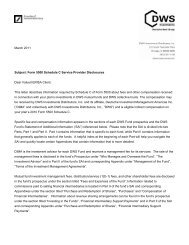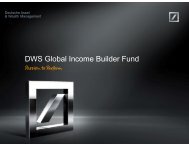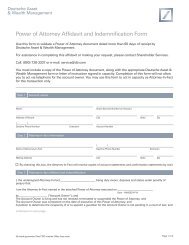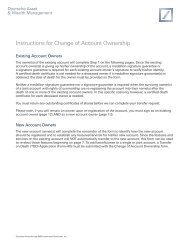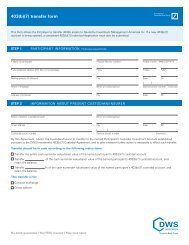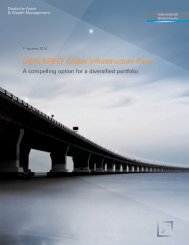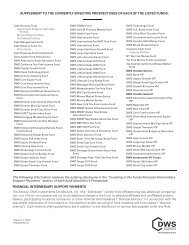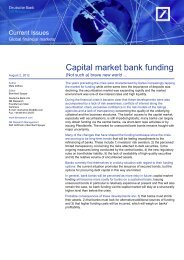Conducting your annual plan review - DWS Investments
Conducting your annual plan review - DWS Investments
Conducting your annual plan review - DWS Investments
- No tags were found...
Create successful ePaper yourself
Turn your PDF publications into a flip-book with our unique Google optimized e-Paper software.
INFORMATION.EVALUATION. OVERSIGHT.<strong>Conducting</strong> an <strong>annual</strong> <strong>plan</strong> <strong>review</strong> is an integral partof sponsoring a retirement <strong>plan</strong>. An <strong>annual</strong> <strong>plan</strong><strong>review</strong> can provide <strong>your</strong> organization with a valuableopportunity to <strong>review</strong> key areas of the <strong>plan</strong> to helpensure that each area is operating effectively, and thatyou are offering a compelling retirement <strong>plan</strong> benefitfor <strong>your</strong> <strong>plan</strong> participants.
Plan snapshotIf you could photograph <strong>your</strong> retirement <strong>plan</strong>, what would it look like? This is the heart of the <strong>annual</strong><strong>plan</strong> <strong>review</strong> process—a snapshot of <strong>your</strong> <strong>plan</strong> that enables you to understand where it has been, whereit is now, and where it should be going. Your <strong>annual</strong> <strong>plan</strong> <strong>review</strong> will also provide you with valuableinsights into how <strong>your</strong> <strong>plan</strong> compares to its peers, as well as detailed assessments of key aspects of<strong>plan</strong> operations.MANAGING RISK AND RESPONSIBILITYCongratulations on sponsoring a <strong>DWS</strong> RetirementServices’ retirement <strong>plan</strong>. We continually strive toprovide the most useful range of quality services inthe industry. It’s all part of our effort to help makeinvesting for retirement easier for <strong>your</strong> employees,and to make <strong>your</strong> retirement <strong>plan</strong> more responsiveand beneficial for <strong>your</strong> company.To achieve fiduciary protection with respect to <strong>your</strong><strong>plan</strong>, you must comply with all necessary ERISAretirement <strong>plan</strong> requirements. The <strong>plan</strong> <strong>review</strong> processis essential to gaining an understanding of howwell you are addressing these responsibilities andrequirements to <strong>your</strong> participants and to the <strong>plan</strong> itself.Besides its value as a measure of <strong>your</strong> <strong>plan</strong>’soperating profile, the <strong>annual</strong> <strong>plan</strong> <strong>review</strong> shouldalso be important to you as a <strong>plan</strong> sponsor for onevery concrete reason. The fiduciary responsibilitiesthat come with being a sponsor of <strong>your</strong> company’sretirement <strong>plan</strong> means that you have responsibilitiesrelating to many <strong>plan</strong> areas, including <strong>plan</strong>management, <strong>plan</strong> design, administration andrecordkeeping, <strong>plan</strong> investments, participantcommunication and education.Within each of these areas you may face fiduciary riskif these responsibilities are not met—and that risk ispersonal. As a <strong>plan</strong> fiduciary, it is <strong>your</strong> duty to ensurethat you act prudently and for the exclusive benefit of<strong>your</strong> participants. Your effectiveness as a fiduciary ismeasured by the good sense of <strong>your</strong> decision-making,<strong>your</strong> judgment and <strong>your</strong> steadfast dedication to asound process.<strong>Conducting</strong> <strong>your</strong> <strong>annual</strong> <strong>plan</strong> <strong>review</strong> » 1
Establishing a retirement <strong>plan</strong> committeeIt’s essential to select the right people for <strong>your</strong> Retirement Plan Committee, and to provide them withthe information they need to help keep <strong>your</strong> <strong>plan</strong> viable and effective.THE ROLE OF THE RETIREMENT PLANCOMMITTEE■■Functions as the decision-making body and fiduciaryof the <strong>plan</strong>■■Helps the <strong>plan</strong> sponsor meet its fiduciaryresponsibilities to <strong>plan</strong> participants■■Oversees the <strong>plan</strong> to meet its obligations as set forthin ERISA■■Provides functional or specific expertise as needed■■Takes the lead in the Plan in Review processA well-structured Retirement Plan Committee canalso help improve the overall management of the <strong>plan</strong>by comparing the total cost of all aspects of the <strong>plan</strong>against the services being received.A Retirement Plan Committee can be formedregardless of the size of <strong>your</strong> organization—committeescan vary in size and structure, and may be comprisedwith as little as one or two individuals representing keyfunctional areas.As a decision-maker for <strong>your</strong> <strong>plan</strong>, you know that thelasting quality of a decision ordinarily means gettingthe right facts to the right people. In this case, youneed to make sure that you appoint the appropriatemembers to serve on <strong>your</strong> Retirement Plan Committee.Because appointing the Retirement Plan Committeeis itself a fiduciary act, it must be handled prudentlyand always with the goal of operating the <strong>plan</strong> for theexclusive benefit of <strong>plan</strong> participants.Once the members of the committee are chosen,a <strong>plan</strong> committee charter should be created. Thischarter should document the purpose, authorityand responsibilities of the committee, includingthe frequency of meetings, rules, procedures andcommittee resources. Likewise, each meeting anddecision made with respect to <strong>plan</strong> committeemembers should also be documented.A Retirement Plan Committee comprised of qualifiedmembers, supported by a robust mandate, anddocumented processes can together help provide oneof the chief defenses against fiduciary liability.The role of the Retirement Plan Committee is typically tohelp the <strong>plan</strong> sponsor meet its fiduciary responsibilitiesto <strong>plan</strong> participants. The Retirement Plan Committeefunctions as both the decision-making body andfiduciary of the <strong>plan</strong>. Committee members should beable to meet the obligations of ERISA and providefunctional or specific expertise to the committee, whichimproves its collective capacity as a fiduciary.<strong>Conducting</strong> <strong>your</strong> <strong>annual</strong> <strong>plan</strong> <strong>review</strong> » 3
KEYS TO AN EFFECTIVE RETIREMENT PLAN COMMITTEE■■Commitment by senior management to the quality of the retirement <strong>plan</strong>■■Knowledge of sufficient breadth to evaluate <strong>plan</strong> data and make informed decisions■■Process that fulfills fiduciary responsibilities by encompassing key areas of <strong>plan</strong> operations and management■■Consistency of execution to ensure the value of the process■■Authority granted to the committee to make decisions that affect the <strong>plan</strong>WHAT ARE THE MAIN OBLIGATIONS OF YOUR RETIREMENT PLAN COMMITTEEWITH RESPECT TO SECTION 404(C) COMPLIANCE? 1To comply with Section 404(c), the Retirement Plan Committee must do all of the following:■■Provide participants with <strong>plan</strong> and investment information to comply with the new Participant Disclosure Regulation,404(a)(5), including specific information about fees associated with the <strong>plan</strong>’s investment options and <strong>plan</strong> services 2■■Notify participants that the <strong>plan</strong> intends to be compliant under Section 404(c)■■Allow participants to choose from a broad range of investment options, with no fewer than three diversifiedinvestment options that offer a variety of risk and return characteristics■■Provide information about any investment option that qualifies as a Qualified Default Investment Alternative(QDIA) and is an approved option to help the <strong>plan</strong> realize additional Safe Harbor protection under Section404(c). The three main QDIA investment options include: target retirement date funds, balanced funds andmanaged accounts■■Provide participants with independent control to move between investment options within their accounts.Participants must be able to give investment instructions with appropriate frequency; for the <strong>plan</strong>’s core funds,transfers must be permitted at least quarterly, at a minimum■■For each investment option, provide descriptions, risk and return characteristics, performance information, andfees and expenses in accordance with the Participant Disclosure Regulation■■Provide instructions to participants on how to obtain additional information■■Record participant information requests as well as a log of how they were fulfilled1Please note that to the following is a general summary of the requirements of Section 404(c), however additional specific requirements forrealizing full fiduciary protection may need to be satisfied. For more information about meeting these specific requirements for <strong>your</strong> <strong>plan</strong>,please contact <strong>your</strong> <strong>plan</strong>’s ERISA counsel.2The Department of Labor (DOL) has recently issued their final rules regarding the requirement of expanded information to be provided toparticipants in disclosing fees and expenses associated with the <strong>plan</strong>, the Participant Disclosure Regulation. The new regulation requires that asof August 30, 2012 (for calendar year <strong>plan</strong>s), participants must be provided with additional, detailed information about the fees and expensesassociated with the <strong>plan</strong> and the <strong>plan</strong>’s investments. This includes new disclosures to help participants understand <strong>plan</strong> expenses and feesbeing paid for services rendered to the <strong>plan</strong> and information to compare investment alternatives on their own. Overall, the goal of the ParticipantDisclosure Regulation is to help participants make more informed decisions about the management of their <strong>plan</strong> account.4 » <strong>Conducting</strong> <strong>your</strong> <strong>annual</strong> <strong>plan</strong> <strong>review</strong>
Beginning the <strong>annual</strong> <strong>plan</strong> <strong>review</strong>After you have determined the frequency and focus of <strong>your</strong> regular Retirement Plan Committeemeetings, you can turn to starting the process for <strong>your</strong> <strong>annual</strong> <strong>plan</strong> <strong>review</strong>.Preparing for the <strong>annual</strong> <strong>plan</strong> <strong>review</strong>, which should occurat the end of <strong>your</strong> <strong>plan</strong> year, consists of three steps:Step 1 | Gathering and sharing information amongdecision-makersStep 2 | <strong>Conducting</strong> the <strong>review</strong>Step 3 | Documenting <strong>your</strong> decisions, includingunresolved issues<strong>DWS</strong> RETIREMENT SERVICES PLANIN REVIEWTo provide you with an <strong>annual</strong> report card for <strong>your</strong><strong>plan</strong>, <strong>DWS</strong> Retirement Services has developed thePlan in Review process that assists you with <strong>your</strong>fiduciary due diligence. Your Relationship Manager,often with the help of <strong>your</strong> Financial Advisor, willinitiate this process by scheduling a meeting to <strong>review</strong>all aspects of <strong>your</strong> <strong>plan</strong> in depth, and present <strong>your</strong>Plan in Review book, a comprehensive <strong>plan</strong> <strong>review</strong>which includes a detailed overview of <strong>plan</strong> statistics,investment performance and industry benchmarks.The Plan in Review process also gives you adocumented summary of:■■Goals completed for the current <strong>plan</strong> year■■Operational achievements■■Educational initiatives■■Section 404(c) compliance and fiduciary requirements■■Legislative updates and changes■■Nondiscrimination test results■■Goals for the upcoming <strong>plan</strong> yearYour Plan in Review book includes the followingdetailed reports:■■Plan statistics■■Plan investments■■Financial market updates■■Plan sponsor servicesWHAT TO EXPECTYour Relationship Manager, in conjunction with<strong>your</strong> Financial Advisor, will work with you todetermine the timing of <strong>your</strong> <strong>annual</strong> <strong>review</strong> and topicsfor discussion. The built-in flexibility of the Plan inReview process also offers <strong>your</strong> Relationship Managerthe ability to customize the process to accommodatespecific requests.You can expect <strong>your</strong> Plan in Review book to help serveas the backbone of <strong>your</strong> <strong>annual</strong> <strong>plan</strong> <strong>review</strong>. It will giveyou data on essential issues that will help you assessthe <strong>plan</strong> and all of its investment options. This will alsohelp you to evaluate the merits of <strong>your</strong> current <strong>plan</strong>design as well as the overall effectiveness of the <strong>plan</strong>for <strong>your</strong> employees.The Plan in Review process is designed to provideyou with all the information you need to effectively<strong>review</strong> and evaluate <strong>your</strong> <strong>plan</strong>. More detailedinformation about the Plan in Review is available from<strong>your</strong> <strong>DWS</strong> Retirement Services Relationship Manager.<strong>Conducting</strong> <strong>your</strong> <strong>annual</strong> <strong>plan</strong> <strong>review</strong> » 5
3 | Changes in <strong>your</strong> organization’sbusiness objectivesIf an aspect of <strong>your</strong> organization’s strategy or businessobjectives has changed, it is quite possible that thebasic design of <strong>your</strong> retirement <strong>plan</strong> may also needfresh attention. For instance, <strong>your</strong> company mayexperience a shift in participant demographics due to amerger or acquisition. Your <strong>DWS</strong> Retirement ServicesRelationship Manager or Financial Advisor can provideyou with information to help you determine whether<strong>your</strong> <strong>plan</strong> design is compatible with <strong>your</strong> organization’scurrent business objectives.Unless due diligence is applied to every area of <strong>plan</strong>activity, it could fall short of helping to protect the<strong>plan</strong> from potential risks such as outdated <strong>plan</strong>documents, noncompliance with ERISA, unreasonablefees and expenses, and/or the unethical practicesof a <strong>plan</strong> fiduciary.“Your <strong>annual</strong> <strong>plan</strong> <strong>review</strong> should be the mostvisible and recurring part of <strong>your</strong> regular duediligence process.”THE IMPORTANCE OF DUE DILIGENCEDue diligence is the process of systematicallyevaluating information to identify risks, issues andassociated costs related to a proposed service offering.Due diligence is also any investigation conducted bythe fiduciary (e.g., the <strong>plan</strong> sponsor, the RetirementPlan Committee or an Investment Committee) tovalidate that the <strong>plan</strong>’s operations and investmentsare meeting their objectives at a reasonable cost, andto find and evaluate alternatives if they are not. Duediligence is a key concept that applies to nearly allareas of fiduciary activity.Your <strong>annual</strong> <strong>plan</strong> <strong>review</strong> should be the most visibleand recurring part of <strong>your</strong> regular due diligenceprocess. Only by establishing and continuallyexecuting this process can you help ensure that <strong>your</strong><strong>plan</strong>’s expenses, service providers and investmentperformance are keeping up with the overall market.In short-sighted <strong>plan</strong>s, the practice of due diligenceis usually applied only to the terms of the <strong>plan</strong>’sInvestment Policy Statement and fails to cover the fullspectrum of <strong>plan</strong> services.KEYS TO DUE DILIGENCEDeveloping <strong>your</strong> own due diligence process for <strong>your</strong><strong>plan</strong> will involve incorporating the following activities:■■Establishing a criteria for evaluating investment orprovider services■■Best practices for choosing and evaluatinginvestment options and service vendors■■Understanding each element in the <strong>plan</strong>’s <strong>annual</strong> feeand expense breakdown■■Comparing investment performance toappropriate benchmarksYour due diligence on each individual provider shouldinclude an assessment of the following characteristics:■■Knowledge and experience of 401(k)retirement <strong>plan</strong> principles■■Market profile■■Range and quality of products and services,including customer service■■Pricing■■Regulatory history■■Ethical practices<strong>Conducting</strong> <strong>your</strong> <strong>annual</strong> <strong>plan</strong> <strong>review</strong> » 7
PLAN ADMINISTRATIONAND RECORDKEEPINGKeeping accurate records of <strong>plan</strong> data and managingits administration are two of the most essentialfunctions of the <strong>plan</strong>’s sponsor. Careful <strong>review</strong> of theserecords and data can help prevent potential futureproblems with regard to key <strong>plan</strong> areas.Your <strong>annual</strong> <strong>review</strong> should include an assessment ofeach of the following administrative and recordkeepingfunctions within the <strong>plan</strong>:Administration■■Testing of contribution limits (e.g., 415, andelective deferrals)■■Determination of investment earnings allocations■■Determination of vested account balances■■Reconciliation of outstanding participantloan balances■■Consistency of hardship determinations with theterms of the <strong>plan</strong> document■■Review of distribution processing upon terminationof employment, retirement, death or disability■■Confirm that all applicable ‘covered service providers’ 1to the <strong>plan</strong> have provided timely applicabledisclosures required under the DOL’s new serviceprovider compensation disclosure requirement,Section 408(b)(2) of ERISA (effective July 1, 2012)■■Confirmation that all required nondiscrimination(ADP and ACP) testing has been properlyconducted, including corrections, if necessary■■Review of <strong>annual</strong> Internal Revenue Service (IRS)limits for:––Elective deferrals––Annual compensation limits––Catch-up contributions––Defined contribution dollar limits––Highly compensated employee threshold––Social Security taxable wage base––Medicare taxable wage baseRecordkeeping■■Reconciliation of employee data■■Determination of <strong>plan</strong> coverage and eligibility■■Summary of profit sharing and otheremployer contributionsSubstantiation that <strong>plan</strong> reporting and disclosurerequirements have been met■■Summary Annual Report (SAR)■■Quarterly benefit statements to participants■■File Form 5500 Annual Report with the IRS■■If <strong>your</strong> <strong>plan</strong> is a participant-directed <strong>plan</strong>, ensure thatthe <strong>plan</strong> complies with the Participant DisclosureRegulation and that copies of relevant disclosuresare provided by Aug. 30, 2012 (for calendaryear <strong>plan</strong>s) as well as new fee information in thequarterly participant statement (the first suchquarterly statement must be provided no later thanNovember 14, 2012 for calendar year <strong>plan</strong>s)■■Summary Plan Description (SPD) and any materialmodifications thereto have been distributed to <strong>plan</strong>participants and beneficiariesManaging <strong>plan</strong> reportsPlan sponsors are ultimately responsible for makingsure that the <strong>plan</strong> operates in compliance withfiduciary requirements. As such, procedures should bein place to see to it that all required nondiscrimination(ADP and ACP) testing is properly completed, includingany corrective distributions.1See page 12 for definition and information on ‘covered service providers’.8 » <strong>Conducting</strong> <strong>your</strong> <strong>annual</strong> <strong>plan</strong> <strong>review</strong>
Always documentAny changes you make in <strong>your</strong> <strong>plan</strong> design,administrative procedures, or recordkeeping shouldbe documented, signed, dated and maintained as apermanent part of the <strong>plan</strong> records. Your <strong>plan</strong> mayrequire individual amendments for each change, or itmay require that <strong>your</strong> <strong>plan</strong>’s prototype document beamended. You should check with <strong>your</strong> <strong>plan</strong>’s ERISAcounsel and <strong>DWS</strong> Retirement Services RelationshipManager before adopting any new <strong>plan</strong> amendment.In addition, you should also make sure that the <strong>plan</strong>’sSPD is kept up-to-date and supplemented with aSummary of Material Modifications (SMM) for anymaterial <strong>plan</strong> change. Under the Participant DisclosureRegulation you will also need to furnish participantsa description of changes to previously disclosedinformation at least 30 days, but not more than 90days in advance of the effective date of such change.Every year the <strong>plan</strong> must meet certain reporting anddisclosure requirements. These requirements includedistribution of the <strong>plan</strong>’s Summary Annual Report(SAR) and quarterly benefit statements to participants,filing a Form 5500 Annual Report with the IRS andquarterly and <strong>annual</strong> disclosures under the ParticipantDisclosure Regulation. Periodically, SPDs, SMMs andparticipant disclosures SMMs must be distributed toreflect material changes. Also, make sure to <strong>review</strong> <strong>your</strong><strong>plan</strong> for compliance with legislative updates and currentregulations, including the various <strong>annual</strong> IRS limits for<strong>plan</strong>s that can change from year to year.<strong>DWS</strong> RETIREMENT SERVICES TOOLSTO HELP YOU■■Your Fiduciary Resource: 2012 EssentialsOur 2012 Essentials website and seminarpresentation contain everything <strong>your</strong> <strong>plan</strong> needs tounderstand the new Participant Disclosure Regulationand 408(b)(2) service provider rules. Materials onthe site include articles, checklists as well as a 2012compliance calendar■■Plan in Review book along with <strong>your</strong> Planin Review meeting, will provide you with valuabledata about key aspects of <strong>your</strong> <strong>plan</strong>, including<strong>plan</strong> statistics, investment performance andproducts and services associated with <strong>your</strong> <strong>plan</strong>■■ClientScope TM is used by <strong>your</strong> RelationshipManager to perform an in-depth analysis todetermine the efficiency, effectiveness andcompetitiveness of <strong>your</strong> organization’s retirement<strong>plan</strong>. ClientScope will analyze four strategiccategories—investments, communication andeducation, operations and administration, andERISA/compliance to check <strong>your</strong> <strong>plan</strong>’s adherenceto industry guidelines and best practices. Specificareas of improvement will also be noted, ensuringthat you are using all available resources formaximum advantage, convenience and valueWHAT IF YOUR PLAN IS AUDITED?If <strong>your</strong> <strong>plan</strong> is audited by the IRS or DOL,documentation is important because it establishes thetrail of evidence that reveals that <strong>your</strong> process wasprudent and within the accepted norms of fiduciarybehavior and <strong>your</strong> <strong>plan</strong> met all legal requirements.Maintaining a complete, signed and dated writtenrecord of <strong>your</strong> <strong>annual</strong> <strong>plan</strong> <strong>review</strong>—including a recordof all decisions made as well as next steps taken toimplement those decisions—can help you demonstratethat you made a practical effort to meet <strong>your</strong> fiduciaryresponsibilities with respect to each aspect of the <strong>plan</strong>.<strong>Conducting</strong> <strong>your</strong> <strong>annual</strong> <strong>plan</strong> <strong>review</strong> » 9
<strong>Investments</strong>Because suitable investments are an essential element of a retirement <strong>plan</strong> offering, the selection andmonitoring of investment options is one of the most important responsibilities of the <strong>plan</strong> sponsor.FOLLOW A THREE-STEPPROCESS TO DETERMINE SUITABLEINVESTMENT OPTIONSStep 1 | SelectStep 2 | MonitorStep 3 | DocumentStep 2 | MonitorThe <strong>plan</strong>’s Investment Committee should formally<strong>review</strong> fund characteristics and the performance ofeach investment option at least <strong>annual</strong>ly. In manycases, semi<strong>annual</strong> or quarterly <strong>review</strong>s of investmentoptions may be prudent.THE PLAN’S INVESTMENT COMMITTEETo meet their fiduciary responsibilities, <strong>plan</strong> sponsorsfrequently establish an Investment Committee thatis distinct from the Retirement Plan Committee. TheRetirement Plan Committee should <strong>review</strong> key areasof the <strong>plan</strong>, while the Investment Committee shouldfocus on <strong>review</strong>ing the <strong>plan</strong>’s investment options.Having some members serve on both committees,however, is possible and sometimes advisable.The primary responsibilities of the InvestmentCommittee are limited to the selection, monitoringand evaluation of the <strong>plan</strong>’s investment options. Inpractice, the Investment Committee first establishesthe Investment Policy Statement and makes its initialselection of the investment options. Thereafter, thecommittee conducts periodic <strong>review</strong>s and evaluatesthe <strong>plan</strong>’s investment options on an ongoing basis,while documenting its findings and decisions.Step 3 | DocumentWithout exception, every <strong>review</strong> by the InvestmentCommittee should be maintained in a written record,including minutes of any meetings. The record shouldalso include all decisions made by the committee,such as the rationale for placing or removing optionson the watch list, and the next steps to implementthese decisions. Meeting minutes should be madeavailable to the Retirement Plan Committee and theorganization’s Board of Directors. Documentation iskey to demonstrating that <strong>your</strong> organization followed aprudent process to meet its fiduciary obligations.Step 1 | SelectOnce <strong>your</strong> <strong>plan</strong>’s Investment Committee has beenestablished, and an Investment Policy Statementhas been approved, the committee should selectinvestment options that correspond to the criteriaspecified by the statement itself.10 » <strong>Conducting</strong> <strong>your</strong> <strong>annual</strong> <strong>plan</strong> <strong>review</strong>
SELECTION PROCESSAn investment <strong>review</strong> compares the <strong>plan</strong>’s investmentresults to relevant indices and benchmarks. A<strong>review</strong> should include evaluating current risk/returncharacteristics and investment strategy for eachfund against their original selection criteria in theInvestment Policy Statement to ensure that the optiondid not drift from its intended place on the <strong>plan</strong>’srisk/return spectrum.If individual investment options no longer fit <strong>your</strong><strong>plan</strong>’s investment policy, the investment <strong>review</strong> isan appropriate time to consider fund additions orreplacements. Before replacing a fund, the InvestmentCommittee may wish to place it on “alert” or “watch”status for a documented period of time. Creating analert or watch list ensures that the replacement iswarranted and also serves to provide written evidenceof the committee’s rationale for each decision.<strong>DWS</strong> RETIREMENT SERVICES TOOLSTO HELP YOU■■Fiduciary Library Series Guide: Building anEffective Investment Policy Statement can actas a starting point for establishing <strong>your</strong> company’sown investment policy. This educational guide canhelp you create an Investment Policy Statement for<strong>your</strong> <strong>plan</strong>, including information about tiers, typesof investments, asset classes to be represented,and management approach■■<strong>DWS</strong> Retirement Services’ Enrollment Kitprovides complete educational information foreach eligible employee about their retirementsavings <strong>plan</strong> and <strong>plan</strong> investment options. Eachkit is customized on the <strong>plan</strong> level, includingspecific <strong>plan</strong> highlights as well as information aboutinvestment options including fund objective(s),investor profile, ticker symbol, fund performanceand fund fees and expenses■■Performance Analysis Reports (PARs), intandem with a risk spectrum chart customizedfor <strong>your</strong> <strong>plan</strong>’s current investment line-up, canenable you to <strong>review</strong> an investment’s long-termperformance relative to its benchmark and peergroup, its investment style, and its risk and returnprofile. This information, can help you best evaluatethe investment options in <strong>your</strong> <strong>plan</strong> 1■■See the Fiduciary Oversight tab within thePlan Sponsor section of dws-investments.com for articles about choosing and monitoring<strong>plan</strong> investments that will help you meet <strong>your</strong>fiduciary obligation to participants. In addition, thesite also offers information related to setting up andmanaging <strong>your</strong> <strong>plan</strong>’s investment menu■■<strong>DWS</strong> <strong>Investments</strong> also provides regular economicand market commentaries on the financial marketsand the U.S. economy at dws-investments.com1All investments involve risk and past performance is no guarantee of future results.<strong>Conducting</strong> <strong>your</strong> <strong>annual</strong> <strong>plan</strong> <strong>review</strong> » 11
SERVICE PROVIDERS AND FEESSelecting competent service providers and monitoringthe value of their services are two necessaryresponsibilities of a <strong>plan</strong> sponsor. In addition, <strong>plan</strong>sponsors are also required to carry out their dutiesprudently and solely in the interest of the <strong>plan</strong>’sparticipants and their beneficiaries. To do this,sponsors have an obligation to investigate and fullyunderstand all costs associated with the <strong>plan</strong>, thenecessity of the services provided and the impactof expenses on participant accounts, and to insurethat the costs associated with each of the servicesrendered are “reasonable.”Your <strong>annual</strong> <strong>plan</strong> <strong>review</strong> helps you carry out theseresponsibilities by following a prudent process to selectand supervise service providers and to determine howthey are compensated. This process may now be easierbecause of the enactment of new service providerdisclosure rules under ERISA 408(b)(2) that went intoeffect on July 1, 2012 for all new and existing ‘coveredservice provider’ arrangements. These rules now require‘covered service providers’ 1 to provide responsiblefiduciaries with information they need to accuratelyassess reasonableness of total compensation, bothdirect and indirect, received by the covered serviceprovider, its affiliates, and/or subcontractors; identifypotential conflicts of interest; and satisfy reporting anddisclosure requirements under ERISA, including underthe Participant Disclosure Regulation.IMPORTANT SERVICE PROVIDERCONSIDERATIONSYour <strong>annual</strong> <strong>plan</strong> <strong>review</strong> should document <strong>your</strong>selection and monitoring of the following aspects ofeach (both covered and non-covered) service provider:■■Complete description of services■■Cost of services, including direct and indirectcompensation as well as termination fees, for‘covered service providers’■■History and experience■■Comparable client base■■Investment fees and expenses■■Participant satisfaction, including quality of services■■Outsourced services and compensation includingstatus as a fiduciary or Registered InvestmentAdvisor for covered service providers■■Overall financial condition■■Commitment to the retirement <strong>plan</strong> business■■Insurance, bonding, and licensing, if applicable1In general, a covered service provider is a service provider who enters into a contract or arrangement with the <strong>plan</strong> and expects to receive $1,000or more over the life of the arrangement for providing services to the <strong>plan</strong> and who falls into one of the following categories: serves as a fiduciaryto the <strong>plan</strong> or to an entity or investment product that holds ‘<strong>plan</strong> assets’ in which the <strong>plan</strong> invests or provides services to the <strong>plan</strong> or such entityregistered investment advisor; provides recordkeeping or brokerage services in connection with making investment options available (e.g. througha platform); or provides other services (e.g. legal, accounting) if the service provider expects to receive indirect compensation, (i.e. compensationthat is not paid by the <strong>plan</strong> or <strong>plan</strong> sponsor).12 » <strong>Conducting</strong> <strong>your</strong> <strong>annual</strong> <strong>plan</strong> <strong>review</strong>
THREE CATEGORIES OF PLAN FEES1 | Plan Administration Fees for <strong>plan</strong> operation andadministration including recordkeeping, accounting,legal and trustee services.2 | Investment Fees for investment managementand other services associated with managing <strong>plan</strong>investments. These fees are charged to individualaccounts based on participants’ investment choices,and <strong>plan</strong> sponsors historically have not been able toreadily assess the amount of these fees.3 | Individual Service Fees are typically for optional<strong>plan</strong> administration features such as participant loans.Managing service providersThe size and complexity of <strong>your</strong> <strong>plan</strong> and the scope of<strong>your</strong> organization will affect the spectrum of servicesyou will need from external providers. Some of therequired services for <strong>your</strong> <strong>plan</strong> may include legalguidance, accounting, trustee/custodial services,recordkeeping, investment management, investmenteducation or participant advice. Prudent oversightof <strong>your</strong> <strong>plan</strong>’s service providers begins with anexamination of the services they provide, the cost ofthese services, the quality of the provider’s work, and ahistory of their business practices.To determine whether the fee for a service isreasonable, you must gather information that specifies:■■All the sources of revenue received by theservice provider■■The total amount of revenue generated fromthese sources■■The total amount of fees that the service providerreceived through the investment choices offeredunder <strong>your</strong> <strong>plan</strong>■■Whether the service provider employs third partiesto perform any of the services, and if so, what feesare paid to themTogether, these will give you a basis on which to helpdetermine whether the costs to the <strong>plan</strong> are justifiedby the value of the services received. To meet <strong>your</strong>fiduciary responsibility, you are not required to selectthe least costly provider, however, you should considerthe total charges against the full range and specificquality of the services to be provided to <strong>your</strong> <strong>plan</strong>and its participants.As mentioned above, effective July 1, 2012, all‘covered service providers’ must now include specificdetails about each service arrangement, otherwise,the arrangement or contract will not be considered“reasonable“ and may violate prohibited transactionrules, with potential severe penalties, including penaltytax consequences, for both the service providerand <strong>plan</strong> fiduciary. A periodic <strong>review</strong> of providerperformance will also help ensure that non-coveredservice providers are offering services in a mannerand at a cost consistent with <strong>your</strong> <strong>plan</strong> agreement. Apotentially revealing aspect of <strong>your</strong> <strong>annual</strong> <strong>plan</strong> <strong>review</strong>would be to consider comments or complaints from<strong>plan</strong> participants about their service experiences.The terms of any agreements or contracts signedwith service providers and their associated fees andexpenses must also be fully understood by the relevant<strong>plan</strong> fiduciary. If the service provider will handle<strong>plan</strong> assets, check to see if the service provider hasfiduciary liability insurance and a fidelity bond.<strong>Conducting</strong> <strong>your</strong> <strong>annual</strong> <strong>plan</strong> <strong>review</strong> » 13
Some providers must be licensed such as attorneys,accountants, investment managers and financialadvisors. You can check with state or federal licensingauthorities to confirm the provider has an up-to- datelicense and whether there are any complaints pending,including any recent litigation or enforcement actions.Finally, as part of <strong>your</strong> due diligence, prepare a writtenrecord of the process followed in <strong>review</strong>ing potentialservice providers, and the reasons for <strong>your</strong> selection ofa particular provider.DocumentationOnly after conducting a due diligence process on thefees and expenses of <strong>your</strong> service providers can youdetermine them to be reasonable. To limit <strong>your</strong> liabilityexposure as a <strong>plan</strong> fiduciary, document <strong>your</strong> evaluationof <strong>plan</strong> fees and expenses, <strong>your</strong> decision-makingprocess, and its results. This documentation should bemaintained in <strong>plan</strong> records.CommunicationAfter evaluating and documenting the due diligenceprocess on fees and expenses, the final step in a <strong>plan</strong>sponsor’s responsibilities involves communicatingfee information to <strong>plan</strong> participants. As mentionedpreviously, the Participant Disclosure Regulationrequires information about <strong>plan</strong>-level and account-levelfees be communicated to participants.Additional considerations regardingadvice and advisorsFiduciaries who select investment advice programsto be made available to <strong>plan</strong> participants are subjectto the same fiduciary duty to prudently monitor theseinvestment advisors—regardless of whether theadvice arrangement was established under the newexemption from specific ERISA prohibited transactionsprovided for in the Pension Protection Act of 2006(PPA). The prudent monitoring of a investment adviceprovider gives a fiduciary a measure of protection fromliability for the advice furnished by the advisor.When monitoring these investment advisors,fiduciaries should periodically <strong>review</strong>:■■Any changes in the information used to select theinvestment advisor■■Whether applicable federal and state securities lawrequirements continue to be met■■Whether advice furnished to participants andbeneficiaries is based upon generally acceptedinvestment theories■■Whether the provider is complying with thecontractual provisions of the arrangement■■An assessment of the use of investment adviceservices by the participants relative to their costto the <strong>plan</strong>■■Participant satisfaction with the quality of theadvice being provided14 » <strong>Conducting</strong> <strong>your</strong> <strong>annual</strong> <strong>plan</strong> <strong>review</strong>
<strong>DWS</strong> Retirement Services tools to help you■■<strong>DWS</strong> Retirement Services’ customized FeeTransparency Report helps <strong>plan</strong> sponsors assessand document their <strong>plan</strong> fees and expenses. Thisreport, based on DOL Fee Disclosure guidelines,can help improve understanding of the fees andexpenses associated with <strong>your</strong> <strong>plan</strong>■■The participant account statement, providedquarterly, shows participants their total accountassets as well as changes in account value, minusany administrative expenses■■A fund prospectus and fund fact sheet specifyinvestment management fees■■Your <strong>plan</strong>’s Summary Plan Description (SPD)may describe administrative expenses paid by the<strong>plan</strong>, the employer or by the participant■■Your <strong>plan</strong>’s Summary Annual Report (SAR) showsaggregate administrative fees and other expenses paidby the <strong>plan</strong> included in the Form 5500 Series Report■■Access to a third party advisory tool,GuidedChoice®. GuidedChoice is a personalizedinvestment advisory program designed to helpparticipants reach their retirement savings goals.Two account options are available: ManagedAccounts and Guidance 1SHOULD YOUR INVESTMENTCOMMITTEE OR PLAN FIDUCIARYCHOOSE INVESTMENT OPTIONSWITH THE LOWEST FEES?To meet <strong>your</strong> fiduciary responsibility, committees andfiduciaries are not required to select the least costlyprovider in any aspect of <strong>your</strong> <strong>plan</strong> or its individualinstruments. Your determination of “reasonable”expenses should evaluate the total charges against therange and quality of the services or the investments tobe provided to the <strong>plan</strong> and its participants.1Neither <strong>DWS</strong> <strong>Investments</strong>, Deutsche <strong>Investments</strong> Management Americas, Inc., and their affiliates, nor ADP, Inc. and its affiliates are affiliated withGuidedChoice® Inc. nor do they endorse GuidedChoice services. GuidedSavings SM is offered through and is the property of GuidedChoice AssetManagement, Inc. GuidedChoice Asset Management, Inc. is a registered investment adviser and a wholly-owned subsidiary of GuidedChoice, Inc.Plans wishing to offer this participant advisory service may engage GuidedChoice to make available investment advisory and management servicesto <strong>plan</strong> participants. While this tool can help identify an investment strategy, for many investors there are some circumstances where it may not beappropriate. Investing in mutual funds involves risk.<strong>Conducting</strong> <strong>your</strong> <strong>annual</strong> <strong>plan</strong> <strong>review</strong> » 15
Participant communication and educationYour <strong>plan</strong>’s communication and education program provides insight into personal investing, andpromotes the <strong>plan</strong>—so employees understand and participate more fully.KEY TOPICS TO BE COMMUNICATED■■Requirements for <strong>plan</strong> participation■■Advantages of saving for retirement■■Basic concepts of saving, compoundingand accumulation■■General understanding of investments andthe investment options offered within the <strong>plan</strong>■■Comprehension of the <strong>plan</strong>’s termsAs a <strong>plan</strong> sponsor, you have an interest in doing allthat you can to help enable <strong>plan</strong> participants to savefor retirement. The more <strong>your</strong> employees understandabout the importance of saving and investing forretirement, the better informed they will be, andthe higher the likelihood that they will begin to takeaction. Effective communication and education notonly provide an opportunity to build <strong>plan</strong> enrollmentbut also provide the potential to reduce fiduciaryliability, increase deferral percentages, and improveasset allocation.READY, AIM, TARGETCommunication programs are often most successfulwhen there is a high level of <strong>plan</strong> sponsor involvement,tailored to <strong>your</strong> specific employee demographics, andwhen employee responses are measured to evaluatethe effectiveness of the communication efforts.In addition, you should consistently remind <strong>plan</strong>participants of their responsibility to prepare for theirfinancial needs in retirement and should clarify specificinformation about investment options.Your <strong>plan</strong>’s communication program should notlimit itself only to traditional forms of employeecommunications, such as employee meetings offeredduring office hours. A variety of communicationstactics such as the following can be utilized to helpdrive participation:■■Offering promotional materials■■Providing personalized communications■■Encouraging employee feedback, participantcommunication and educationEnhancing <strong>your</strong> current <strong>plan</strong> features can also bea beneficial way to encourage participation. Someadditional enhancements to consider are listed below:■■Providing a matching contribution, or increasingthe existing match■■Adding additional investment alternatives■■Implementing automatic enrollment withauto-deferral increases■■Adding a hardship withdrawal provision■■Adding a participant loan provision16 » <strong>Conducting</strong> <strong>your</strong> <strong>annual</strong> <strong>plan</strong> <strong>review</strong>
Once you have established the right mix ofcommunication methods and materials to suit theneeds of <strong>your</strong> employees, make a <strong>plan</strong> and write itdown. This communication <strong>plan</strong>, which can be createdwith the help of <strong>your</strong> <strong>plan</strong>’s <strong>DWS</strong> Retirement ServicesRelationship Manager or Financial Advisor, shouldinclude a list of individual communication initiatives(e.g., meetings, brochures, web education, new<strong>plan</strong> features), a brief rationale of how this list wasdetermined, and a schedule of <strong>plan</strong>ned communicationevents for the coming year.As with all other aspects of <strong>plan</strong> operations and <strong>review</strong>,documentation of the <strong>plan</strong>’s communication programis essential. You should maintain a record of eachcommunication utilized with employees, includingthose mentioned above to gauge their effectiveness.Documenting <strong>your</strong> education initiatives and satisfactionof ERISA disclosure requirements is also important.Disclosures to participantsThe <strong>plan</strong> sponsor is obligated to share basic informationwith each participant about how the <strong>plan</strong> works as wellas the scope of the participant’s rights and interests.The <strong>plan</strong>’s SPD provides participants with informationabout specific <strong>plan</strong> provisions such as eligibility andhow benefits are calculated, become vested and aredistributed. An updated SPD should also be provided toparticipants that incorporates all the changes reflectedin the <strong>plan</strong>’s SMM at least every five years. Additionalinformation may be provided to the participant throughadministrative forms. Each participant should also beencouraged to understand how his or her contributions,investment earnings and investment choices can impacthis or her retirement portfolio over time.ADDITIONAL INFORMATION TO PROVIDETO PLAN PARTICIPANTS SHOULD INCLUDE 1■■Required <strong>annual</strong> investment disclosures mustnow be provided to all <strong>plan</strong> participants startingon August 30, 2012 (for calendar year <strong>plan</strong>s).These disclosures under the Participant DisclosureRegulation include:––An ex<strong>plan</strong>ation of how participants may giveinvestment instructions––An ex<strong>plan</strong>ation of any specific limits on suchinstructions under the <strong>plan</strong>––A description or reference regarding exercise ofvoting or other rights––Identification of any designated investmentalternatives, including identifying information,the category of investment (e.g. money marketfund, balanced fund, etc.), performance data,benchmarks, fee and expense information, internetaddress for additional investment information, andadditional investment-related information for eachdesignated investment option available 2––Identification of any designated investment manager––Description of any brokerage window or similararrangement allowing investments beyond thosedesignated by the <strong>plan</strong>––Fees and expenses for general <strong>plan</strong> services,including basis on which charges will beallocated, and––Fees and expenses that may be charged toindividual participant accounts■■A quarterly participant statement that includesthe participant’s account balances, current assetallocation, transaction history and investmentperformance for each investment option offeredin the <strong>plan</strong>1This is a general description of the required disclosure items and is not intended to be a comprehensive list.2Investment related information with respect to each designated investment alternative must be provided in a comprehensive format. The DOL hasprovided a safe harbor comparative chart that may be used for this purpose.<strong>Conducting</strong> <strong>your</strong> <strong>annual</strong> <strong>plan</strong> <strong>review</strong> » 17
■■A quarterly statement under the ParticipantDisclosure Regulation disclosing fees and expensesactually charged to the participant for the quarterand a description of the services to which thechanges relate■■The <strong>plan</strong>’s Summary Annual Report (SAR)reflecting the <strong>plan</strong>’s current financial condition anda summary of the year’s income■■Information and forms on hardship withdrawals,participant loans and Qualified DomesticRelations Orders (QDROs), blackout periods,and Section 404(c), automatic enrollmentand QDIA disclosures must also be provided,where applicable■■A Summary of Material Modifications (SMM)should be distributed to <strong>plan</strong> participants if the <strong>plan</strong>has been materially amendedQDIA COMMUNICATION REQUIREMENTSCurrently, relief from certain liability exposure isgranted to fiduciaries where the default investmentoption under the <strong>plan</strong> is a QDIA and where the relatedQDIA rules are followed, including the followingdisclosures to participants:■■Circumstances under which assets may beinvested in a QDIA■■Right of participants and beneficiaries todirect investments■■Objectives, expenses and risk/return characteristicsrelated to the QDIA■■Right of participants and beneficiaries to directassets invested in the QDIA investment to anotherinvestment option, including any related restrictions,fees and expenses■■Sources of more information about the <strong>plan</strong>’s otherinvestment optionsThe DOL has issued proposed regulations regardingthe type of information participants must receive abouta <strong>plan</strong>’s QDIA option. Generally, this new disclosurefocuses on the QDIA’s investment objective, principalstrategy, principal risks, historical performance andfees and expenses. The purpose of the proposedregulation is to help ensure participants have sufficientinformation to make an informed investment decision.Once these proposed regulations are finalized, <strong>plan</strong>fiduciaries will need to develop procedures to ensurecompliance with the final regulations.PLAN SPONSORS SHOULD ALWAYS BEPREPARED TO PROVIDE INFORMATIONTO PARTICIPANTS REGARDING ANY OFTHE FOLLOWING■■Type(s) of investment education available■■Whether services are provided by a single provideror multiple providers■■How to access the retirement <strong>plan</strong> (througheither a voice response system number, employeeservice center or 800-number or web address)■■Whether the <strong>plan</strong>’s optional services(e.g., participant loans) are being utilizedby <strong>plan</strong> participants■■How administrative services and investmentmanagement fees are paid■■Whether the investment performance ofindividual options is benchmarked againstappropriate market indices■■If sales charges, 12b-1 fees, surrender charges orother fees apply to the investment options■■Whether special funds or special classes of stockare available as investment options18 » <strong>Conducting</strong> <strong>your</strong> <strong>annual</strong> <strong>plan</strong> <strong>review</strong>
<strong>DWS</strong> RETIREMENT SERVICES TOOLS TOHELP YOU■■<strong>DWS</strong> Retirement Services’ Personalized Mailersare targeted for quick and efficient participantresponse. Mailers are built to address a variety of<strong>plan</strong> challenges with messaging that speaks directlyto the individual. Three mailer versions—enrollnow, company match and increasing deferrals, areavailable and include a business reply card for quickand easy employee response■■Personalized and customized Enrollment KitUtilizing a state-of-the-art publishing system,<strong>DWS</strong> <strong>Investments</strong> is able to produce a print-ondemand enrollment kit that is customized on the<strong>plan</strong> level, tailored to meet the specific needs of<strong>your</strong> organization. Comprehensive educationalcontent includes the following:––Plan highlights information––Fund fact sheets, including information aboutinvestment option including fund objective(s),investor profile, ticker symbol, fund performanceand fund fees and expenses––Customized, <strong>plan</strong>-specific forms■■<strong>DWS</strong>’ Retirement Services award-winning 1retirement <strong>plan</strong>ning education program:Our <strong>DWS</strong> Education Program is a complete suiteof education solutions designed for participantsto address retirement <strong>plan</strong>ning for each individualsituation and life-stage.Focus: Program drives results in three key areas:increase participation and contributions, improveasset allocation and diversificationPersonalization: Industry-recognized solutions 1that talk directly to the employee. May bepersonalized and customized on three levels: by<strong>plan</strong>, by life-stage, and by account informationMultiple media: Delivered through multiple mediafor maximum effect. Includes the use of online,in-print and in-person methods, as well as emergingformats such as podcasts, interactive multimediapresentations and eLearning modules. Selectedmaterials available for foreign language translation■■Quarterly newsletters provide timely andeducational news articles and information1Includes awards from Pension and <strong>Investments</strong>, 2011 Eddy Award, <strong>DWS</strong> Personalized Communications, Mutual Fund Education Alliance (MFEA)2009 STAR Awards, Best Plan Participant Introduction Kit; Profit Sharing Council of America (PSCA) 2008 Signature Awards, Gold Award for <strong>DWS</strong>Enrollment Kit; 2009 Communicator Awards, Awards of Distinction for <strong>DWS</strong> Personalized Mailers, Retirement Planner, Participant Calculators andRetirement Focus Print Newsletter.<strong>Conducting</strong> <strong>your</strong> <strong>annual</strong> <strong>plan</strong> <strong>review</strong> » 19
Putting all togetherThe conclusion of an <strong>annual</strong> <strong>review</strong> should consist of grading the status of <strong>your</strong> <strong>plan</strong>—creating a <strong>plan</strong><strong>annual</strong> report card. A comparison of the current state of <strong>your</strong> <strong>plan</strong> to previous years, as well as to the restof the industry, can be made through this report card, showing a grade for each specific area of <strong>your</strong> <strong>plan</strong>.The conclusion of an <strong>annual</strong> <strong>review</strong> should consistof grading the status of <strong>your</strong> <strong>plan</strong>—creating a <strong>plan</strong><strong>annual</strong> report card. A comparison of the current stateof <strong>your</strong> <strong>plan</strong> to previous years, as well as to the restof the industry, can be made through this report card,showing a grade for each specific area of <strong>your</strong> <strong>plan</strong>.The value of the <strong>annual</strong> <strong>plan</strong> <strong>review</strong> and itscorresponding report card can serve as acomprehensive overview, as well as a timely snapshotof each individual facet of <strong>your</strong> <strong>plan</strong>. Putting <strong>plan</strong>data together into a report card also provides youwith a valuable tool to develop strategies for theupcoming <strong>plan</strong> year.SUCCESS BEGINS WITH MEASUREMENTFor a practical and thorough <strong>annual</strong> <strong>review</strong>, werecommend that you use the <strong>DWS</strong> RetirementServices Plan in Review process in tandem with allof the other applicable tools outlined in this guide.Together, these will help <strong>your</strong> <strong>plan</strong> evolve andimprove to better meet the needs of <strong>your</strong> organizationand <strong>your</strong> employees.ONCE A YEAR, STARTING NOWRemember, the <strong>annual</strong> <strong>plan</strong> <strong>review</strong> is one of the besttools for evaluating the success of <strong>your</strong> <strong>plan</strong>, findingnew strategies for <strong>your</strong> <strong>plan</strong>’s objectives, and managing<strong>your</strong> fiduciary liability as <strong>plan</strong> sponsor. It’s never toosoon to get started with <strong>your</strong> <strong>annual</strong> <strong>plan</strong> <strong>review</strong>process. To begin, contact <strong>your</strong> <strong>DWS</strong> RetirementServices Relationship Manager who will help you getstarted on creating a practical <strong>plan</strong> of action.HOW OFTEN SHOULD YOUR PLANCONDUCT A PLAN REVIEW?True to its name, the <strong>annual</strong> <strong>plan</strong> <strong>review</strong> shouldtake place no less than once a year. Often <strong>plan</strong>swill have more frequent <strong>review</strong>s for specificaspects of the <strong>plan</strong> – for example, many <strong>plan</strong>sperform quarterly investment <strong>review</strong>s through theirInvestment Committees.Once the <strong>annual</strong> <strong>plan</strong> <strong>review</strong> is completed, one ofthe most important things to do is to follow up onany potential problems or issues that have beenuncovered. By identifying specific steps to take,<strong>DWS</strong> Retirement Services’ Plan in Review andClientScope tools are designed to help you keeptrack of the time between investment <strong>review</strong>s.The ClientScope report will give you a sense of howwell <strong>your</strong> <strong>plan</strong> compares with accepted industrypractices. With this report, you can identify specificareas to improve and you can begin to work with <strong>your</strong><strong>DWS</strong> Retirement Services Relationship Manager andFinancial Advisor to put a strategy in place to advance<strong>your</strong> <strong>plan</strong> to the next level.20 » <strong>Conducting</strong> <strong>your</strong> <strong>annual</strong> <strong>plan</strong> <strong>review</strong>
CHART YOUR COURSEParticipation in the <strong>DWS</strong> Retirement Services Plan inReview process is designed to provide you with all theinformation you need up-front to effectively <strong>review</strong> andevaluate <strong>your</strong> <strong>plan</strong>.More information about the Plan in Review is availablefrom <strong>your</strong> <strong>DWS</strong> Retirement Services RelationshipManager or <strong>your</strong> Retirement Services Representative.<strong>Conducting</strong> <strong>your</strong> <strong>annual</strong> <strong>plan</strong> <strong>review</strong> » 21
The information provided is for educational purposes only and is not intended to serve and should not be relied upon as legal,tax or securities advice or construed as such. Specific questions and application of specific rules to a particular <strong>plan</strong> should beaddressed by competent ERISA counsel.OBTAIN A PROSPECTUSTo obtain a summary prospectus, if available, or prospectus, download one from www.dws-investments.com, talk to<strong>your</strong> financial representative or call 1-800-522-1441. We advise you to carefully consider the product’s objectives, risks,charges and expenses before investing. The summary prospectus and prospectus contain this and other importantinformation about the investment product. Please read the prospectus carefully before you invest. All investmentsinvolve risk including potential loss of principal.All investments involve risk,including possible loss of principal.<strong>DWS</strong> <strong>Investments</strong> is part of Deutsche Bank’sAsset Management division and, within the U.S.,represents the retail asset management activities ofDeutsche Bank AG, Deutsche Bank Trust CompanyAmericas, Deutsche Investment ManagementAmericas Inc. and <strong>DWS</strong> Trust Company.<strong>DWS</strong> <strong>Investments</strong> Distributors, Inc.222 South Riverside Plaza Chicago, IL 60606-5808www.dws-investments.com rep@dws.comTel (800) 621-1148© 2012 <strong>DWS</strong> <strong>Investments</strong> Distributors, Inc. All rights reserved. RS123901-A (8/12) R-8701-7 PLS-GD10





